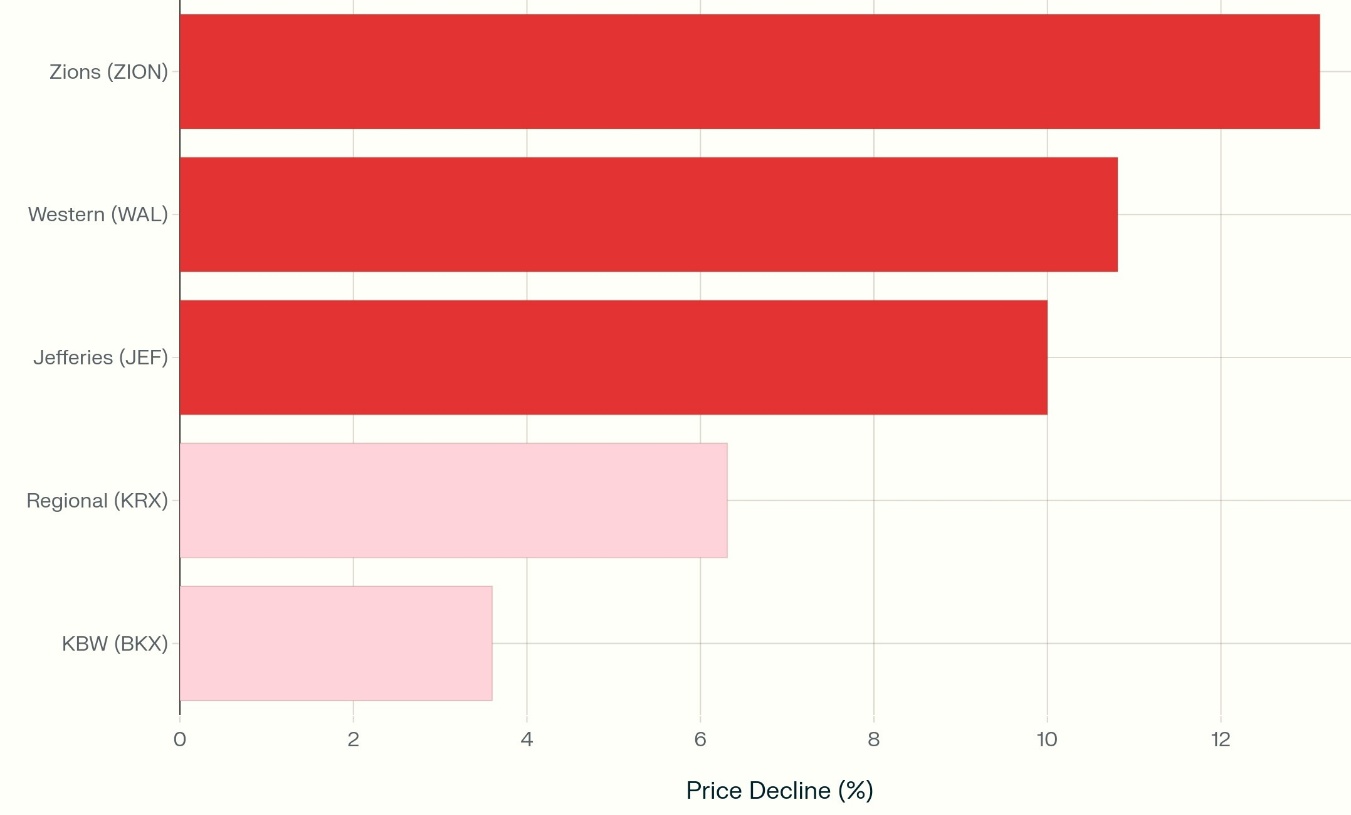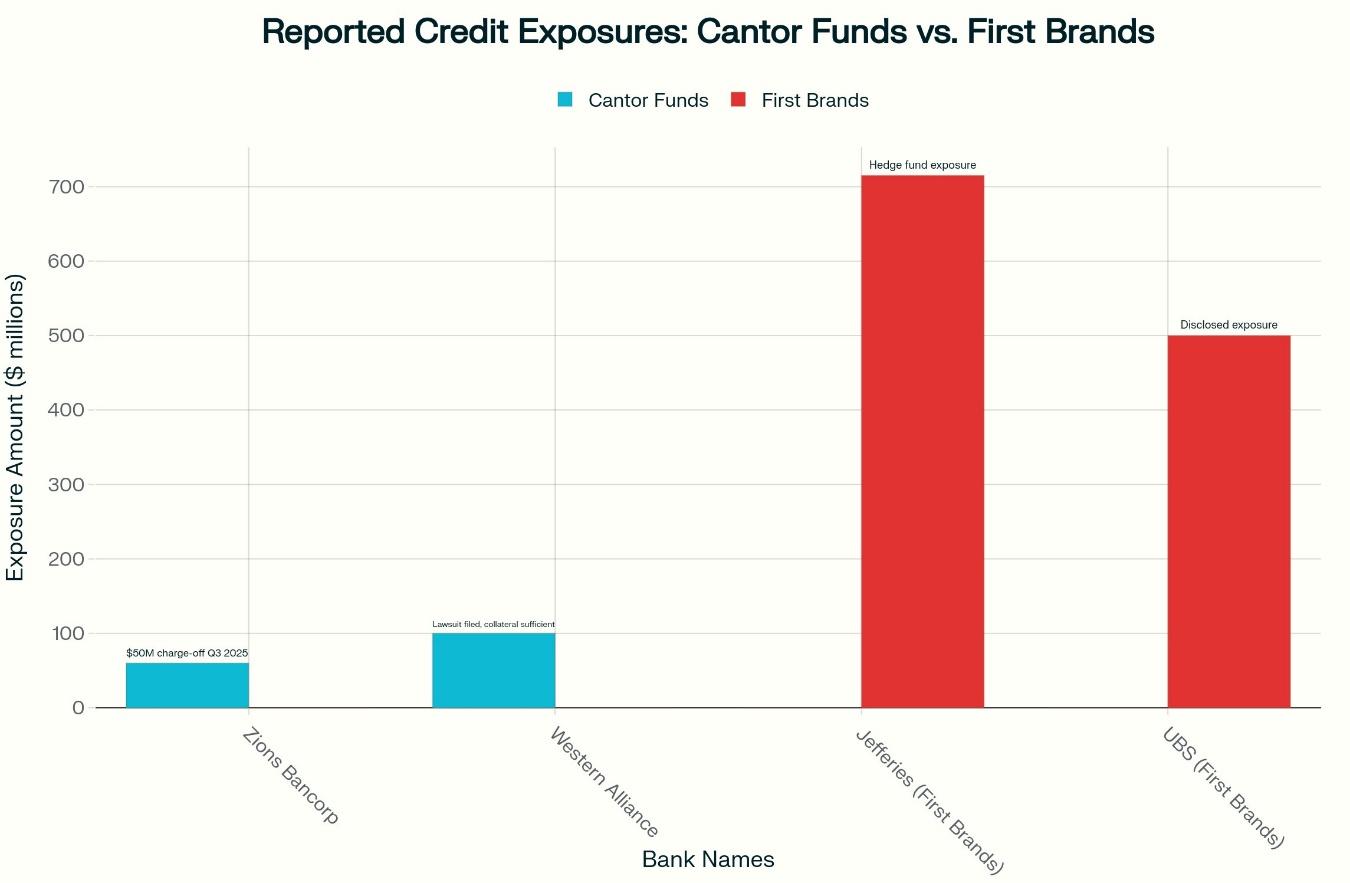InvestingPro’s Fair Value model captures 63% gain in Steelcase ahead of acquisition
How revolving credit facilities to opportunistic funds create opacity, misaligned incentives, and concentrated tail risk for regional lenders
When regional banks disclosed hundreds of millions in revolving credit to distressed-debt funds linked to Cantor Fitzgerald, share prices tumbled 8-15% in single sessions. The KBW Regional Banking Index fell 6.3% on the worst day. Investors recoiled at the financing structure itself: revolving credit to opportunistic funds amplifies uncertainty in ways traditional credit analysis can’t capture. Banks’ lending to distressed-debt funds creates opaque risk and misaligned incentives that can convert isolated losses into bank-level shocks.
Why This Product Creates Unique Risk
Revolving credit facilities to distressed-debt funds differ fundamentally from traditional commercial lending. A fund purchases distressed loans or troubled assets at steep discounts, then draws on a bank-provided revolver to finance those positions. The bank earns fees and interest; the fund gains leverage.
Three problems emerge. First, collateral is already distressed paper with elevated revaluation risk. Second, the revolving structure means funds can draw liquidity continuously until the facility is pulled, creating sudden crunches when problems surface. Third, operational coupling creates information asymmetries: funds have incentives to delay reporting NAV declines while banks profit from fees that depend on keeping facilities active.
Post-Silicon Valley Bank, investors remain hypersensitive to surprise exposures in bank asset quality. Modest exposures to opaque credit structures now trigger disproportionate valuation repricing. Opacity plus leverage plus misaligned incentives equals rapid confidence shocks.
What the Numbers Show
8-K filings and investor presentations from affected banks indicate combined exposure ranging from $200 million to over $500 million across facilities linked to distressed-fund borrowers. For institutions with $10-30 billion in total assets, a $100 million exposure represents 30-100 basis points of tangible common equity.
October 16, 2025. Stock Price Impact

Chart showing the severity of the selloff across individual banks and indices, on October 16, 2025, following fraud disclosures, with Zions down 13.14%, Western Alliance down 10.81%, and the KBW Regional Banking Index falling 6.31%.
How Revolvers Amplify the Problem
Continuous funding availability means banks face real-time exposure to collateral deterioration without the natural maturity limits of term loans. When fund assets decline (through market moves or misrepresentation), the bank has already funded the position.
Incentive misalignment becomes severe. Funds want to maintain positions and may underreport NAV declines to avoid margin calls. Banks earn attractive spreads and fees, creating pressure to underprice moral hazard. Recent disclosures show several banks maintained or increased facility sizes even as fund performance metrics deteriorated.
Collateral valuation becomes perpetual negotiation rather than fixed underwriting. Unlike traditional secured lending (real estate appraisals, equipment valuations), distressed debt requires subjective judgments about workout value, recovery timelines, and restructuring outcomes. This masks true risk until crystallization events force recognition.
The Opacity Problem
Four factors make these exposures nearly impossible for outside analysts to quantify:
- Limited public reporting on fund NAVs and underlying asset performance
- Short-notice draw capabilities that materially change exposure between quarterly reports
- Transfer pricing complexity when the same institution provides lending and advisory services
- Non-standard collateral valuation lacking market clearing prices
Neither equity analysts nor risk managers can reliably model tail risk. By the time problems surface in regulatory filings, market repricing is severe and indiscriminate.
 Chart comparing Cantor fund exposures ($60M Zions, $100M Western Alliance) against First Brands exposures ($715M Jefferies, $500M UBS), showing the relative scale across different credit events.
Chart comparing Cantor fund exposures ($60M Zions, $100M Western Alliance) against First Brands exposures ($715M Jefferies, $500M UBS), showing the relative scale across different credit events.
What Investors Should Watch
Re-price risk premiums. Regional bank credits deserve higher discounts until disclosure improves or underwriting tightens. Reduce position sizes or widen stop-losses on regionals with known exposure to asset-backed revolvers.
Monitor disclosure language. Watch 8-K filings and 10-Q footnotes for "asset-backed revolver," "fund facility," or changes to margin trigger language. These signal brewing problems before analyst calls acknowledge them.
Consider hedging. Out-of-the-money puts on exposed regionals offer asymmetric payoff potential. Alternatively, rotate into bank ETFs that underweight regionals or favor large-cap banks with stronger disclosure.
Watch for M&A. Prolonged confidence issues and depressed valuations increase acquisition likelihood. Patient investors might find value if capital raises prove less dilutive than feared.
Price in regulatory risk. Greater scrutiny will likely require enhanced reporting and tighter concentration limits, translating to higher compliance costs and compressed margins.
Quick checklist: Review disclosure quality around off-balance exposures; quantify concentrations to funds or asset-backed facilities; cross-reference fund NAV statements when available.
The Counterarguments
Skeptics say this was idiosyncratic fraud, not product failure. But even if misrepresentation explains the specific event, the financing structure created the channel for material bank exposure and market contagion. Product design determines whether failures stay contained or cascade.
Others point to covenants and contractual protections. True, but covenants can be weakened through amendments, and covenant waivers during stress are routine. Reputational damage and market confidence operate on different timelines than contractual protections. Banks can be legally whole yet suffer significant equity value destruction.
Finally, regulatory supervision typically responds after crises, not before. Unless reporting standards and lending practices change proactively, opacity remains the dominant feature. The compliance lag means at least one more cycle before structural fixes take hold.
The Path Forward
The Cantor-linked fallout exposes structural product risk, not merely a borrower surprise. Regional banks built profitable businesses providing liquidity to opportunistic funds without adequately pricing tail risks or informing investors about concentrated exposures.
Expect sustained scrutiny, potential regulatory clarifications, and a market environment that increasingly penalizes opacity. Banks face a choice: tighten underwriting and improve disclosure of fund-linked facilities, or accept that markets will treat these exposures as higher-risk and price accordingly.
Until meaningful changes occur, approach regional banks with known fund-facility exposures with elevated caution. The next problem will emerge. The question is whether banks will have provided enough transparency for markets to price it rationally.
